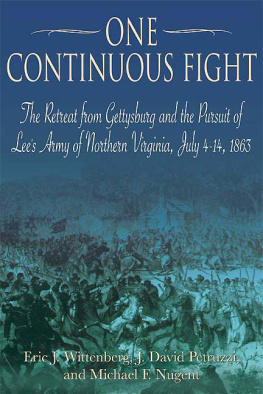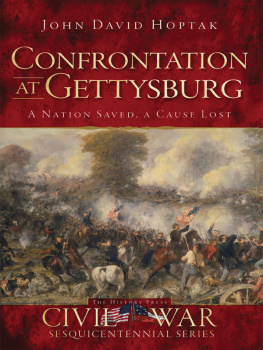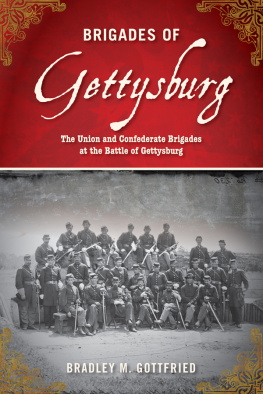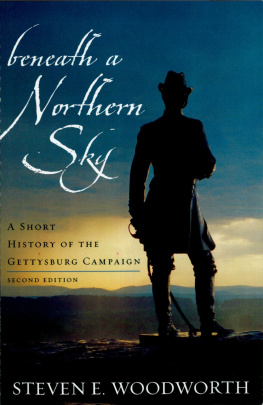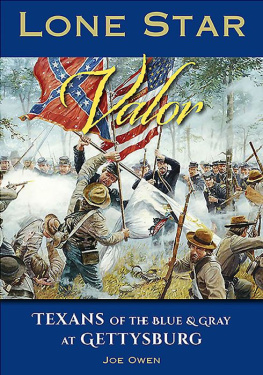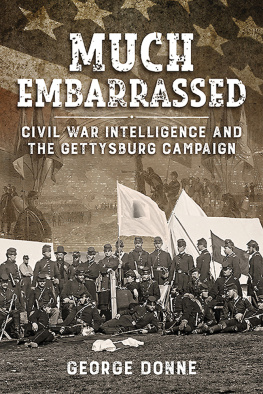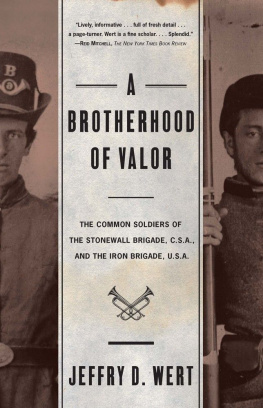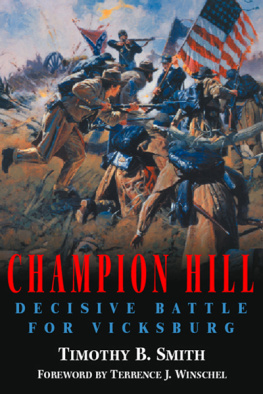Gettysburg
THE SECOND DAY
1987 The University of North Carolina Press
All rights reserved Manufactured in the United States of America
The paper in this book meets the guidelines for
permanence and durability of the Committee
on Production Guidelines for Book Longevity
of the Council on Library Resources
cloth 05 04 03 02 01 10 9 8 7 6
paper 05 04 03 02 01 14 13 12 11 10
Library of Congress Cataloging-in-Publication Data
Pfanz, Harry W.
Gettysburgthe second day.
Bibliography: p.
Includes index.
1. Gettysburg, Battle of, 1863. I. Title.
E475.53.P48 1987 973-7349 87-5965
ISBN 0-8078-1749-x (cloth: alk. paper)
ISBN 0-8078-4730-5 (pbk.: alk. paper)
TO
THE MEMORY OF
Letitia Elizabeth Pfanz,
WHOSE
ANCESTORS FOUGHT FOR BOTH
THE UNION AND THE CONFEDERACY
AND WHO SPENT MOST OF HER
SHORT LIFE ON THIS BATTLEFIELD
CONTENTS
CHAPTER ONE
From the Potomac to Pennsylvania
CHAPTER TWO
The Army of Northern Virginia, 1 July
CHAPTER THREE
The Army of the Potomac, 1 July
CHAPTER FOUR
Meades Scattered Corps Assemble, 2 July
CHAPTER FIVE
The Third Corps, Morning, 2 July
CHAPTER SIX
Confederate Preparations, 2 July
CHAPTER SEVEN
Sickles Takes Up the Forward Line
CHAPTER EIGHT
Longstreets Corps Opens the Attack
CHAPTER NINE
Devils Den
CHAPTER TEN
Little Round Top
CHAPTER ELEVEN
The Opening Attacks in the Wheatfield
CHAPTER TWELVE
The Confederates Seize the Wheatfield
CHAPTER THIRTEEN
McLaws Strikes the Peach Orchard
CHAPTER FOURTEEN
From the Peach Orchard to Cemetery Ridge
CHAPTER FIFTEEN
Andersons Division Attacks
CHAPTER SIXTEEN
The Repulse
CHAPTER SEVENTEEN
Epilogue
MAPS
61. Longstreets Approach March and Troop Positions on Cemetery Ridge and Seminary Ridge at 4:00 P.M.
81. Confrontation on the Federal Left: Hoods Division Advances
91. The Action at Devils Den
101. Little Round Top: The Opening Assault
102. Little Round Top: The Final Assault
111. The Wheatfield: The Opening Attack
121. The Wheatfield: Caldwell Sweeps the Field
122. The Confederates Seize the Wheatfield
131. The Peach Orchard
151. Barksdales, Wilcoxs, and Perrys Brigades Attack Humphreyss Position along the Emmitsburg Road
152. Wright and Posey Attack the Union Center
161. The Repulse on the Union Left
162. The Repulse at the Union Center
ILLUSTRATIONS
Gen. Robert E. Lee /
Maj. Gen. George G. Meade /
Lt. Gen. James Longstreet /
Lt. Gen. Ambrose P. Hill /
Maj. Gen. Winfield S. Hancock /
Maj. Gen. Daniel E. Sickles /
Maj. Gen. George Sykes /
Brig. Gen. John C. Caldwell /
Brig. Gen. John Gibbon /
Maj. Gen. David B. Birney /
Brig. Gen. Andrew A. Humphreys /
Brig. Gen. James Barnes /
Brig. Gen. Romeyn B. Ayres /
Brig. Gen. Samuel W. Crawford /
Meades headquarters and the Taneytown Road /
Cemetery Ridge from Little Round Top /
Maj. Gen. Daniel E. Sickles and staff/
Maj. Gen. John B. Hood /
Maj. Gen. Richard H. Anderson /
Maj. Gen. Lafayette McLaws /
Col. E. Porter Alexander /
Lt. Col. Freeman McGilvery /
Capt. George E. Randolph /
Brig. Gen. Andrew A. Humphreys and staff/
Brig. Gen. Jerome B. Robertson /
Brig. Gen. Henry L. Benning /
Brig. Gen. J. H. Hobart Ward /
Col. A. Van Horne Ellis /
Slaughter Pen /
At Devils Den/
Brig. Gen. Gouverneur K. Warren /
Col. Strong Vincent /
Brig. Gen. Evander M. Law /
Little Round Top from Devils Den /
Little Round Top from the northwest /
Col. William C. Oates /
Col. Joshua L. Chamberlain /
Col. Patrick H. ORorke /
Brig. Gen. Stephen H. Weed /
Brig. Gen. Joseph B. Kershaw /
Brig. Gen. George T. Anderson /
Col. Jacob B. Sweitzer /
Col. William S. Tilton /
Col. P. Regis de Trobriand /
Company C, 110th Pennsylvania Volunteer Infantry Regiment /
Kershaw attacks Winslows battery in the Wheatfield /
Col. Edward E. Cross /
Brig. Gen. Samuel K. Zook /
Col. Patrick Kelly /
Col. John R. Brooke /
Brig. Gen. Paul J. Semmes /
Brig. Gen. William T. Wofford /
The Wheatfield /
Col. Sidney Burbank /
Col. Hannibal Day /
The Ninth Massachusetts Battery going into position /
The Peach Orchard /
Birneys division awaits Kershaws attack near the Peach Orchard /
Brig. Gen. Charles K. Graham /
Brig. Gen. William Barksdale /
Col. Benjamin G. Humphreys /
Col. Henry J. Madill /
Col. Edward L. Bailey /
Captain Phillips bringing off a gun by prolonge /
Lines of the Confederate advance on Bigelows battery /
Miltons section, Ninth Massachusetts Battery, going over the wall /
Brig. Gen. Cadmus M. Wilcox /
Col. David Lang /
Brig. Gen. Joseph B. Carr /
Col. William R. Brewster /
Col. George C. Burling /
Brig. Gen. Ambrose R. Wright /
Brig. Gen. Carnot Posey /
Col. William McCandless /
Col. Joseph W. Fisher /
Pennsylvania Reservesthe Valley of Death /
Col. George L. Willard /
Col. William Colvill, Jr. /
Col. Francis V. Randall /
Brig. Gen. William Harrow /
Col. Norman J. Hall /
Brig. Gen. Alexander S. Webb /
Union dead /
Dead horses of Bigelows battery in the Trostle farmyard /
PREFACE
This is an account of the major action at Gettysburg on 2 July 1863fought in the three hours prior to darkness on the second day of that enormous battle. It was the assault by the Army of Northern Virginia against the left and center of the Army of the Potomac. Lieutenant General James Longstreet, who commanded two of the three divisions that participated in this Confederate attack, termed the performance of his troops the best three hours fighting ever done by any troops on any battle-field. Few would take great issue with his boast. This hard-fought action introduced Little Round Top, Devils Den, the Wheatfield, and the Peach Orchard to Americas historical vocabulary. The mention of these names once quickened the pulses of the survivors of the action and stirred them in prideand sometimes in defenseof what they and their leaders had done that day. Now the veterans have passed on, and the significance of these places, which was so apparent to them, has faded in mans memory. Such fading is natural, but the veterans of both armies sought to slow its pace. They believed that what they had done at these places was important and sought to preserve the memory of it by erecting memorials on the battlefield and initiating the preservation of the field itself. I hope that this account is a worthy continuation of their preservation effort.
July 2 was a day when many men of both armies performed deeds of great valor and made personal sacrifices that were worthy of the best of their mutual American (and European) heritage. Much of this aspect of the battle is chronicled below. But even the greatest of these men were human and made mistakes. Preparations for the attackand the defensebegan before dawn. There were reconnaissances that supplied incomplete information; there was some indecision and much anxiety; there was misunderstanding if not insubordination in the upper echelons of both armies, and tempers became short. In addition there was hard marching, tiresome waiting, and the usual skirmishing. Finally, the Confederate brigades chosen for the assault stood poised to attack a vulnerable Federal position, and their long-delayed advance beganin accordance with a flawed plan!
Next page

